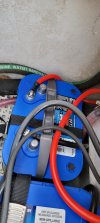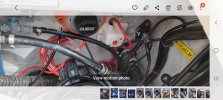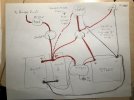- Joined
- Apr 20, 2020
- Messages
- 208
- Reaction score
- 93
- Points
- 28
- Model
- Seafarer
I finally completed the battery upgrade in my 228 as i just added a bunch of electronics and getting ready to install a sterio. Now I have two Optima group 31 AGM deep cycle for house on one switch connected to the motor with the isolator cable and one Optima high performance starting battery connected to a second switch directly to the main and the kicker. Tight fit with both batteries to port but wanted it that way to offset the 9.9 kicker to starboard.
Questions. 1) Should I also run a cable from one of the house batteries to the second battery lead on the starter switch? This would allow me to combine all 3 batteries for an emergency jump start but not sure if this would damage the batteries or starter since both charging leads would be on the same circuit at least momentarily. 2) assuming this red button is a breaker, should it be protecting house or should I move it to the starting battery switch.
Questions. 1) Should I also run a cable from one of the house batteries to the second battery lead on the starter switch? This would allow me to combine all 3 batteries for an emergency jump start but not sure if this would damage the batteries or starter since both charging leads would be on the same circuit at least momentarily. 2) assuming this red button is a breaker, should it be protecting house or should I move it to the starting battery switch.





